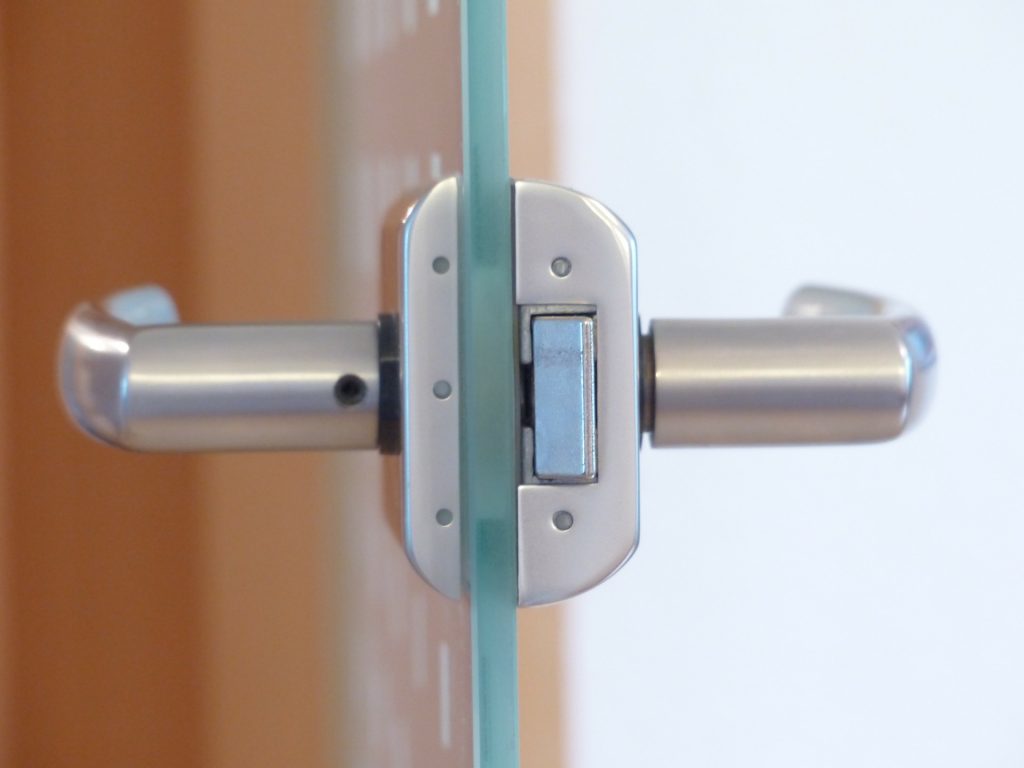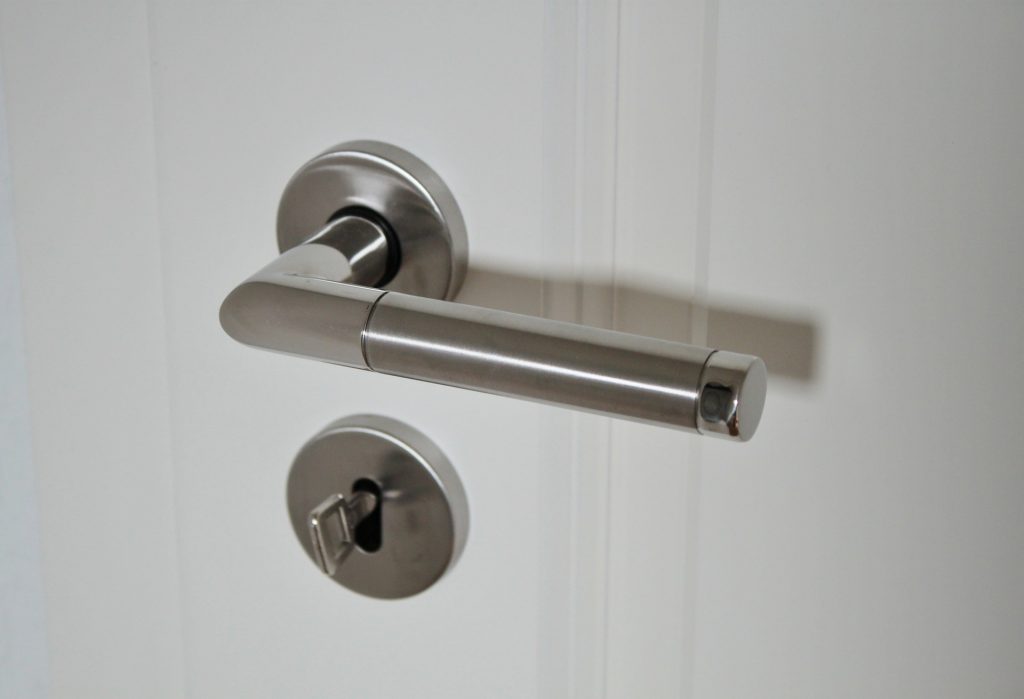Once you've chosen your internal doors you'll need to find a handle that suits. For many homeowners, budget and appearance are the two things to take into consideration. If you’re replacing the door handles in your home, it’s likely that you’re going to be replacing all the handles in your home so set aside a budget that you’re willing to spend on your hinges and hardware before you start shopping.
Once you’ve set your budget, you can then start thinking about the aesthetics. Period properties will benefit from hardware that’s more sympathetic to the style of the home. Brass lever handles and knobs will look particularly attractive in homes like this. In new-builds or more modern homes chrome looks particularly attractive as do more edgy alternatives such as glass.
Today, we’re going to guide you through the process of choosing, and fitting, the right handles for your home.
Choosing Internal Doors Handles
Handles; we don’t really spend all that much time thinking about them until they stop working, or we need to pick out new ones.
Picking the hardware for your doors is important, but the choice can feel overwhelming. How do you choose from so many different styles? What’s the right choice? We’re here to help guide you through how to choose the right door handles for your internal doors.
Types of Door Handle
There are two types of door handle; Lever door handles on a backplate, and lever door handles on rose. There are also door knobs, which can either be functional or decorative.
Door Handles on a Backplate
Door handles with a backplate often feature a vertical rectangular plate with a level handle placed in the middle. Door handles with a backplate are very common and can be used throughout the house as the backplate provides plenty of space for a thumb lock, or traditional keyed lock to sit beneath the handle.
Door Handle on Rose
A door handle on rose has a much more contemporary look than that of a backplate. Most levers are mounted on a small, round rose which isn’t much larger than the diameter of the handle itself. The rose doesn’t have to be circular, though; squares are becoming increasingly popular in today’s minimalist and modern homes.
Doors handles on a rose don’t have space for a lock to be attached to the lever itself. You’ll need to fit a lock separately if you plan to fit these kinds of handles on your bathroom doors.
Door Knobs
Many people use “knob” and “handle” interchangeably when talking about their door fittings, but a knob is slightly different to traditional lever handle. A mortice knob is one of the most common types of door knob. These operate on latch and need to be twisted to release the door. Mortice knobs can be mounted on a rose or on a backplate.
The other type of door knob can be decorative, like the type you find on your cupboards and wardrobes. They don’t have a latch, but you can pull and push a door closed using them.
Fitting Internal Door Handles
Fitting handles and hinges to your door is a basic DIY task that, with a little pre-planning and a few tools, will take you less time than you think.
Fitting Internal Door Handles

What you’ll need:
- Pencil
- Your handle or hinge pack
- Drill with a 2mm drill bit, a slightly larger drill bit (depending on the size screws you’re using), and a 25mm spade bit
- Chisel
How to Fit a Door Handle
First, you need to decide what height you want your door handles to sit at. If you’re replacing existing doors then measure from the floor to the centre of the door handle. Take this measurement and, using a pencil, mark the centre of the door handle on the edge of the door.
Extend this line for about four inches, or 100mm, on either side of the door. Don’t worry; use a light touch and the pencil can be rubbed off with a rubber, or even a damp cloth.
Pick up the latch and hold that flat against the surface of the door and flush with the edge of the door. You then need to mark the centre of the spindle of your handles on your centre line. This is where you’re going to drill the hole for your handle to go through.
The next step is to drill pilot holes in your door. These pilot holes will make drilling the larger holes needed to screw your door handle to the door much easier. Use a 2mm drill bit to drill holes in the spots where the screws on the backplate will need to go.
Refer to any instructions that may have come supplied with your handle kit. Use a larger drill bit to make your pilot holes slightly larger. Don’t drill all the way through the door though, as the wood could splinter.
Now it’s time to drill the hole for your spindle. Add a 25mm spade bit to your drill, and drill through the hole you marked out for the door handle spindle to go through.
Now you’ve got your spindle hole drilled, it’s time to drill a hole for the barrel and latch. Keep the spade bit on your drill and drill in where the barrel will sit.
Insert the latch in to the hole you’ve just drilled and attach the faceplate. Using a pencil, draw around the edge of the faceplate. Remove both and use a utility knife to cut around the outline of the face plate.
Grab your chisel and chisel out a hole for the faceplate to sit in. Keep chiselling and checking until the faceplate sits flush against the door.
You can now screw the latch in to the door and fix it in place.
You now need to install the striker plate. This is where the latch will lock in to place. To work out where you should sit this on the frame of your door, and mark where the middle of the barrel hits the door frame. Open the door, then hold the striker plate up against the frame and mark the top and bottom of the striker plate on the door frame.
Grab your plate bit and drill a hole for the latch to sit in. Then score the outline of the kick plate and chisel it out before you affix the plate to the door.
Attach the handles to the door following the instructions. Attach the backplate and then test your door to make sure the handle works, and the latch retracts when needed before you push your door closed - if anything went wrong, you won’t want to get locked in, or out!
Locking Internal Doors

Whilst there’s not much need to fit a lock on most of your internal doors, there are certain rooms where you might enjoy a little privacy, such as the bathroom. To prevent unwelcome visitors whilst you’re indisposed, you really do need to fit a lock to your door.
Thumb Turn Lock
The most popular lock for bathrooms are thumb locks, or thumb turn locks. These locks allow the person on the inside of the room to lock and unlock the door easily by twisting the knob on the inside of the door. These doors never require a key, so there’s no need to worry about that getting lost and being locked in the bathroom!
Thumb turn locks also can be unlocked from the outside in the case of an emergency. The side of the lock on the outside can be turned using an item like a coin should you ever need to gain access to the room.
Other locks you might come across for internal doors include:
Cylinder Locks
You may need to fit these to your internal doors if you have a door lever mounted on a rose. They are thin cylinders which are drilled through your door and lock and unlock on one side with a key, and lock and unlock on the other side with a thumb turn lock.
Locking Door Knobs
If you have doorknobs rather than levers, you can still fit locks. Some knobs will come pre-fitted with a locking mechanism which is operated using either a key or a thumb lock.
Bolts
If you don’t fancy fitting a lock to your door, then you can fit a bolt instead. A bolt is affixed to one side of the door and a cylinder of metal slides across from the door to a receptor attached to the frame. This allows the person inside the room to lock the door. Whilst this offers the security you might want for the bathroom, the person on the outside can’t unlock the bolt in an emergency, which might not appeal to families with children.
Fitting Internal Door Locks
Fitting a lock to your internal doors is a relatively straightforward task. You’ll need the same tools as listed above for fitting a door handle.
So, there you have it. Our guide to picking, and fitting, door handles and locks for your internal doors.









